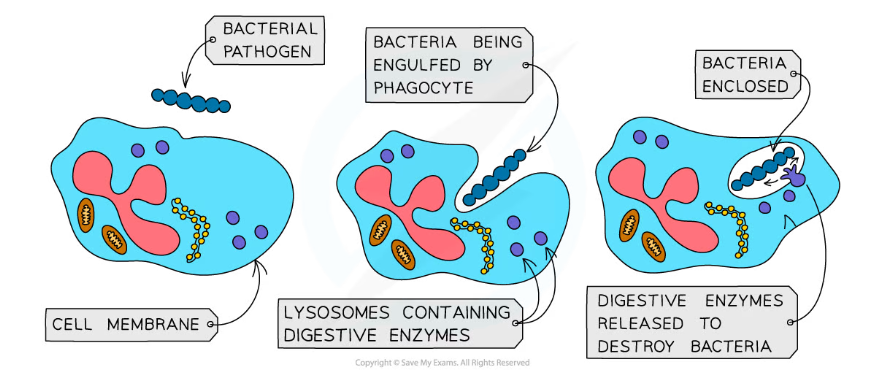- 翰林提供学术活动、国际课程、科研项目一站式留学背景提升服务!
- 400 888 0080
Edexcel A (SNAB) A Level Biology:复习笔记6.2.3 Non-specific Immune Responses
Non-specific Immune Responses
- There are two types of immune response in the body once a pathogen enters
- Non-specific
- This response is the same, regardless of the pathogen that invades the body
- Specific
- This is a response specific to a particular pathogen
- The immune system is able to recognise specific pathogens due to the presence of antigens on their cell surface
- Antigens are molecules such as proteins or glycoproteins located on the surface of cells; their role is to act as an ID tag, identifying a cell as being 'self' or 'non-self'
- Pathogens have non-self antigens, so the immune system recognises them as not belonging to the body
- Antigens are molecules such as proteins or glycoproteins located on the surface of cells; their role is to act as an ID tag, identifying a cell as being 'self' or 'non-self'
- Non-specific
- When a pathogen invades tissue the non-specific immune response begins immediately; this includes
- Inflammation
- Interferons
- Phagocytosis
Inflammation
- The surrounding area of a wound can sometimes become swollen, warm and painful to touch; this is inflammation
- Body cells called mast cells respond to tissue damage by secreting the molecule histamine
- Histamine is a chemical signalling molecule that enables cell signalling, or communication between cells
- Histamine stimulates the following responses
- Vasodilation increases blood flow through capillaries
- Capillary walls become 'leaky', or more permeable, allowing fluid to enter the tissues and creating swelling
- Some plasma proteins leave the blood when the capillaries become more permeable
- Phagocytes leave the blood and enter the tissue to engulf foreign particles
- Cells release cytokines, another cell signalling molecule that triggers an immune response in the infected area
Interferons
- Cells infected by viruses produce anti-viral proteins called interferons
- Interferons prevent viruses from spreading to uninfected cells
- They inhibit the production of viral proteins, preventing the virus from replicating
- They activate white blood cells involved with the specific immune response to destroy infected cells
- They increase the non-specific immune response e.g. by promoting inflammation
Phagocytosis
- Phagocytes are a type of white blood cell responsible for removing dead cells and invasive microorganisms; they do this by engulfing and digesting them
- The process of engulfing and digesting is known as phagocytosis
- Phagocytes travel throughout the body and can leave the blood by squeezing through capillary walls
- During an infection they are released in large numbers
- Mode of action
- Chemicals released by pathogens, as well as chemicals released by the body cells under attack, e.g. histamine, attract phagocytes to the site where the pathogens are located
- They move towards pathogens and recognise the antigens on the surface of the pathogen as being non-self
- The cell surface membrane of a phagocyte extends out and around the pathogen, engulfing it and trapping the pathogen within a phagocytic vacuole
- This part of the process is known as endocytosis
- Enzymes are released into the phagocytic vacuole when lysosomes fuse with it
- These digestive enzymes, which includes lysozyme, digest the pathogen
- After digesting the pathogen, the phagocyte will present the antigens of the pathogen on its cell surface membrane
- The phagocyte becomes what is known as an antigen presenting cell
- The presentation of antigens initiates the specific immune response

Phagocytes engulf pathogens in the process of phagocytosis, enclosing them in a phagocytic vacuole. Lysosomes fuse with the vacuole, releasing enzymes which digest the pathogen.
转载自savemyexams

最新发布
© 2025. All Rights Reserved. 沪ICP备2023009024号-1









